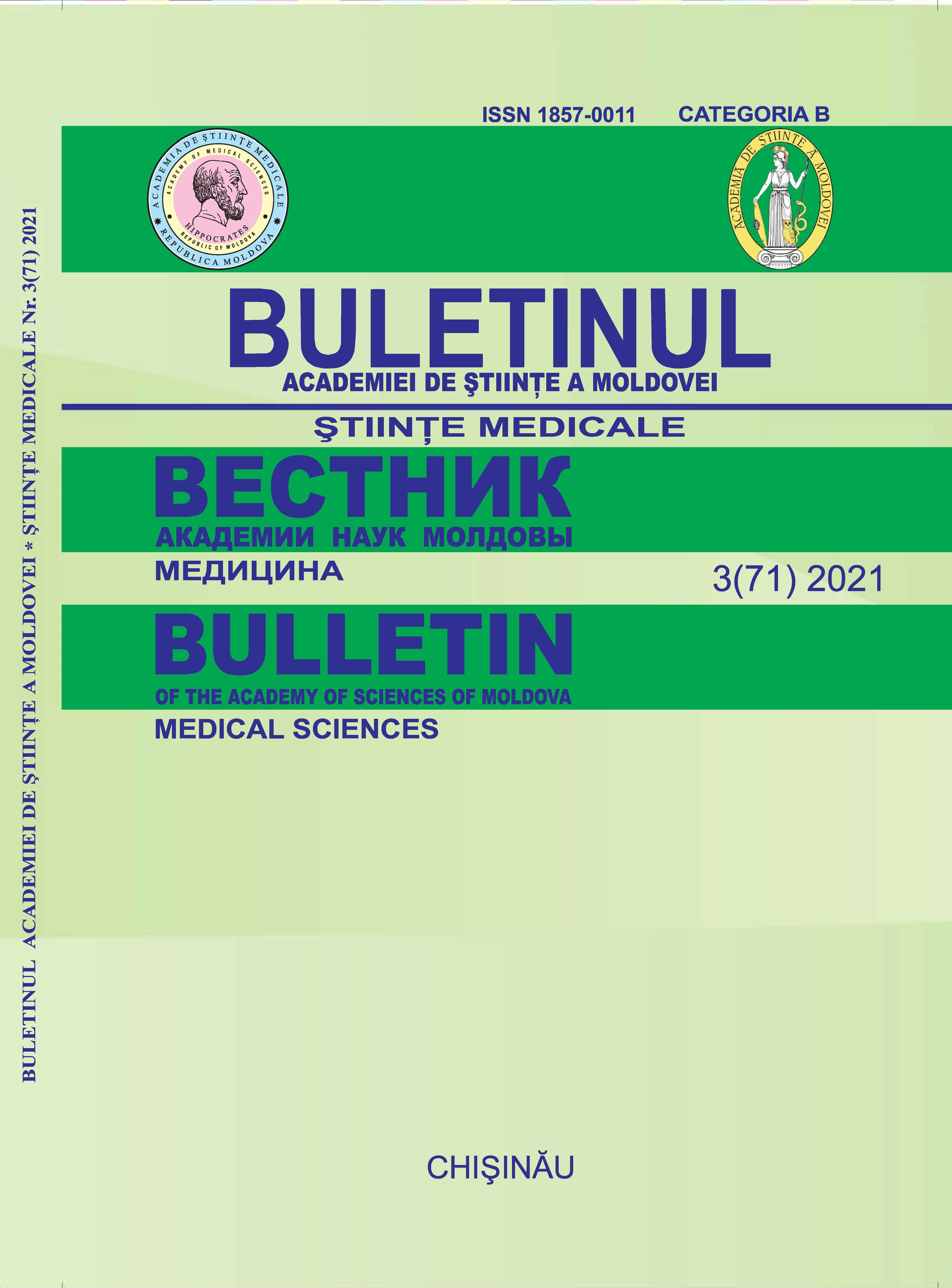Comparative study of genomic, immunological and functional features of squamous cell carcinomas in five anatomical locations
DOI:
https://doi.org/10.52692/1857-0011.2021.3-71.05Keywords:
comparative analysis, bioinformatics, biomarkers, omics data, molecular genetics, immunologyAbstract
Squamous cell carcinomas (SCCs) are the most common human solid tumors and a major cause of cancer mortality.They are a group of aggressive, genetically complex neoplasms with a high risk of recurrence and metastasis. In the Republic of Moldova in 2018 the incidence of head, neck, esophagus, lung, skin and cervical cancers constituted 3242 casesof which about 50% represented the histopathological form of Squamous Cell Carcinoma. Early diagnosis, improving theoutcomes of disease management and adaptation of therapies are current and necessary requirements for reducing mortality.Genetic changes, alteration of intracellular signaling pathways, and immune system response in these cancers may be influenced by various factors such as: oncogenic viruses (HPV), local microbiome, tumor localization, etc. In order to extend theunderstanding and the area of knowledge about these malignancies, to highlight the biological similarities and differencesbetween certain types of SCCs, are required complex, comparative studies of genomic, epigenomic, proteomic, metabolomic, imunological and microbiome events. This complex, comparative approach has not been widely applied in previousstudies and will allow the identification of similarities and differences between the multi-omics and non-omics features, thedetermination of individual and common biomarkers in 5 types of Squamous Cell Carcinomas: skin, head-neck, esophagus,lung and cervical. The goal of the research is the comparative study of SCCs from different anatomical locations in order toimprove the screening, early diagnosis, disease management and treatment of these tumors
References
Bailiang Li, Yi Cui et al., The Immune Subtypes and Landscape of Squamous Cell Carcinoma, Clin Cancer Res, 2019 Jun 15;25(12):3528-3537, doi: 10.1158/1078-0432.CCR-18-4085;
Daniele Ramazzotti, Avantika Lal, Bo Wang, Serafim Batzoglou & Arend Sidow, Multi-omic tumor data reveal diversity of molecular mechanisms that correlate with survival, Nature Communications volume 9, 4453, 26 October 2018, DOI: https://doi.org/10.1038/s41467-018-06921-8;
Francisco Azuaje, Artificial intelligence for precision oncology: beyond patient stratification, npj Precision Oncology volume 3, Article number: 6, 25 February 2019, DOI: https://doi.org/10.1038/s41698-019-0078-1;
Francisco Sanchez - Vega et al., Oncogenic Signaling Pathways in The Cancer Genome Atlas, Cell, Volume 173, ISSUE 2, April 05, 2018, P321-337.e10, DOI: https://doi.org/10.1016/j.cell.2018.03.035;
Freddie Bray, BSc, MSc, PhD et al., Global cancer statistics 2018: GLOBOCAN estimates of incidence and mortality worldwide for 36 cancers in 185 countries, CA CANCER J CLIN 2018 Nov;68(6):394-424, doi: 10.3322/caac.21492;
Jianfang Liu et al., An Integrated TCGA Pan-Cancer Clinical Data Resource to Drive High-Quality Survival Outcome Analytics, Cell, Volume 173, ISSUE 2, April 05, 2018, P400-416.e11, DOI: https://doi.org/10.1016/j.cell.2018.02.052;
Matthew H. Bailey et al., Comprehensive Characterization of Cancer Driver Genes and Mutations, CELL, Volume 173, ISSUE 2, April 05, 2018, P371-385.e18, DOI: https://doi.org/10.1016/j.cell.2018.02.060;
Nezar N. Al-Hebshi, Wenche S. Borgnakke, Newell W. Johnson, The Microbiome of Oral Squamous Cell Carcinomas: a Functional Perspective, Springer International Publishing, 18 April 2019, DOI: https://doi.org/10.1007/s40496-019-0215-5;
Otília Menyhárt and Balázs Győrffy, Multi-omics approaches in cancer research with applications in tumor subtyping, prognosis, and diagnosis, Computational and Structural Biotechnology Journal, Volume 19, 2021, Pages 949-960, doi: https://doi.org/10.1016/j.csbj.2021.01.009;
Sajib Chakraborty, Md. Ismail Hosen, Musaddeque Ahmed, and Hossain Uddin Shekhar, Onco-Multi-OMICS Approach: A New Frontier in Cancer Research, BioMed Research International, 3 October 2018, doi: 10.1155/2018/9836256;
Serghei Mangul et al., How bioinformatics and open data can boost basic science in countries and universities with limited resources, Nature Biotechnology, VOL 37, MARCH 2019, 324–326, DOI: https://doi.org/10.1038/s41587-019-0053-y;
Shankargouda Patil et al., Cancer oriented biobanks: A comprehensive review, Oncol Rev. 2018 Jan 30; 12(1): 357., DOI: 10.4081/oncol.2018.357;
Singer J et al., Bioinformatics for precision oncology, Brief Bioinform. 2019 May 21;20(3):778-788, DOI: 10.1093/bib/bbx143
Vésteinn Thorsson et al., The Immune Landscape of Cancer, Cell, Volume 48, ISSUE 4, April 17, 2018, P812-830.e14, DOI: https://doi.org/10.1016/j.immuni.2018.03.023;
Yingxia Zheng et al., Immune suppressive landscape inthe human esophageal squamous cell carcinoma microenvironment, Nature Communications, Article number: 6268, 08 December 2020, doi: https://doi.org/10.1038/s41467-020-20019-0.
Downloads
Published
Issue
Section
License
Copyright (c) 2022 Bulletin of the Academy of Sciences of Moldova. Medical Sciences

This work is licensed under a Creative Commons Attribution 4.0 International License.



